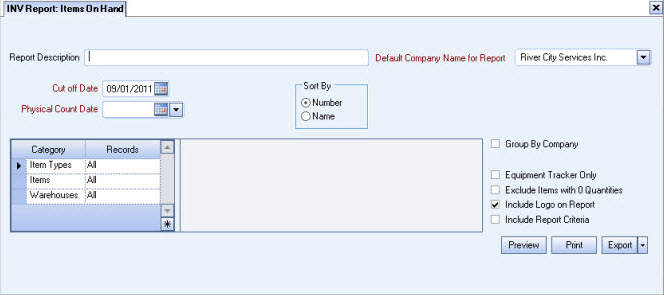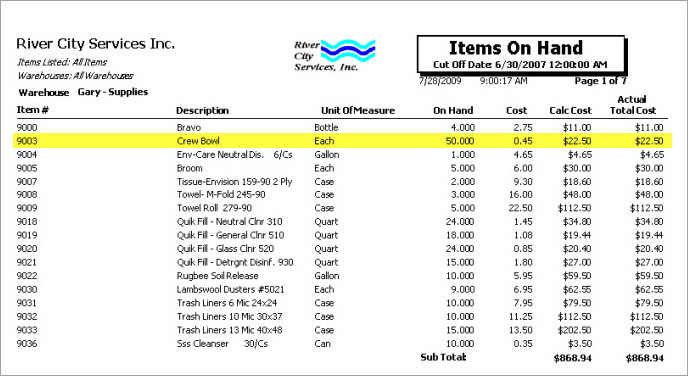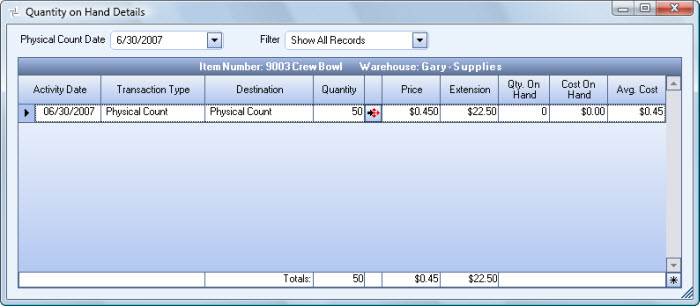Overview
The Inventory On Hand report shows the Quantities On Hand information for each item as of a certain cut off date. Based upon the cut off date selected, the system calculates what the quantities on hand of each item would have been. This report lists all Items, On Hand count, Item Cost and Total Cost.
Note: The item cost printed on this report could either be the Standard Cost or Average Cost depending on which Job Cost Method is indicated for that item in the Item Master File.

Key Functionality
Type a description to name the report. This description prints above the Report Title.
Available for Clients using the Multi-Company feature. The Default Company Name for Report is populated from the Company Setup screen. The list contains all companies you have permission to access. The default company prints on every page of the report.
If the User has permission to only one company, then just that one company will display in the list. If the User has permissions to more than one company, the list will contain all companies the User has rights to PLUS the default reporting company. For more information see Learning about WinTeam Reports.
Enter the Cut Off Date to use to figure the Quantities On Hand as of that particular date. Inventory activity (Received, Sold, Usage and Adjustments) dated after this date will not be included in the report. The default value is "Today's Date."
Enter the Physical Count Date to determine the average cost of items for the period between the selected Physical Count Date and the Cut Off Date.
Note: If you enter a Physical Count Date that did not exist, the system uses the closest Physical Count Date that it can find to the date entered (looking backwards). For example, if a physical count record existed for 6/30/2018 and the date entered on the Physical Count Date field was 7/18/2018, the system looks to the 6/30/18 physical count that was created when displaying the Items On Hand.
Use the Sort By option to sort report data by Item Number or Item Name.
Click Number to sort report data by Item Number. Click Name to sort report data by Item Name.
Item Types
Use the Item Types category to select the inventory Item Types to include on the report.
Select All to include all Item Types on the report.
Select Pick to define specific Item Types for the report. When you select Pick, a list of all Item Types display. Select the check box next to each Item Type to include on the report.
Items
Use the Items category to select the Inventory Items to include on the report.
Select All to include all items in the Item Master File.
Select Range to define a range of item numbers for the report. When you select Range, the range fields display. Type the beginning item number in the From field and the ending item number in the To field.
Select Pick to define specific Items for the report. When you select Pick, the Items list displays. Select the check box next to each Item to include on the report.
Select Create to define your own list of Items. When you select Create, a small grid displays to the right. Enter the Item Numbers you want to include in the list, or use the Lookup to locate the Item Numbers.
Select Exclude to identify records that should not be included. When you select Exclude, a small grid displays to the right. Enter the Item Numbers you want to exclude in the list, or use the Lookup to locate the Item Numbers.
Warehouses
Use the Warehouses category to select the Warehouse Locations to include on the report.
Select All to include all Warehouse Locations on the report.
Select Pick to define specific Warehouse Locations for the report. When you select Pick, a list of Warehouse Locations displays. Select the check box next to each Warehouse Location you want to include the on the report.
This option is available to users who have more than one company, but is not selected by default. If selected, the default company prints on the Grand Total Page and the Report Criteria page. All other pages print the applicable company name. If not selected, the default company prints on every page of the report.
Select the Equipment Tracker Only check box to include only items that are being tracked through Equipment Tracker.
Select the Include Logo on Report check box to print the company logo on the report. This check box is selected or cleared by default, based on the option selected in SYS:Defaults. However, you can modify the setting on each report.
Select the Include Report Criteria check box to include a list of the report options selected for this report. The Report Criteria page includes any ranges specified and each Category/Record selection made for the report. This check box is NOT selected by default.
Note: Multi-Company—WinTeam looks to the Job's Company logo to determine which Company logo to use on the Work Ticket Report and Work Tickets.
Click the Preview button (or use the shortcut key, ALT + V) to view before printing.
The Preview button is available for Detail and Summary Report Types.
Click (or press ALT + P) to send the report to your default printer.
The Print button is available for Detail and Summary Report Types.
Click the Export button (or press ALT + X) to export to a specified format. Reports may be exported to Adobe Acrobat (PDF), Excel, Comma-Separated Values(CSV), Grid View, and E-mail (for premise-based clients only).

Note: The item cost printed on this report could either be the Standard Cost or Average Cost depending on which Job Cost Method is indicated for that item in the Item Master File.
The Actual Total Cost is nothing more than the TOTAL extension amount after all activity for the given period.
For example: Using the Item # 9003, the Actual Total Cost is $22.50 (according to the Items On Hand report).
The Quantity on Hand Details screen for the same activity period reflects a total Extension amount of $22.50. This is the Actual Total Cost reflected on the Items On Hand Report.

